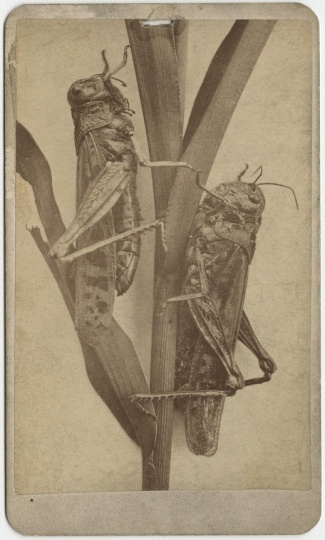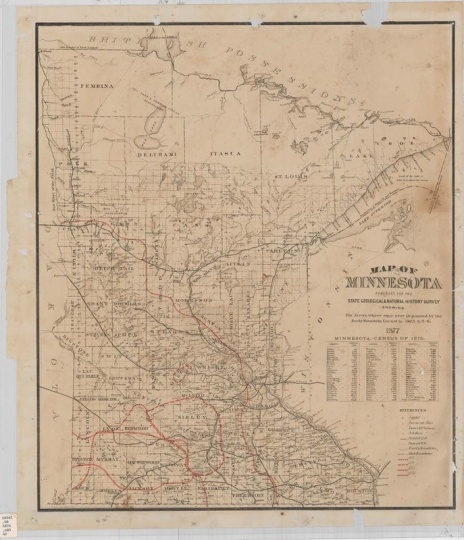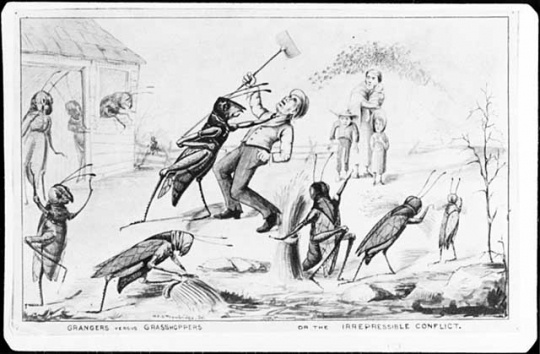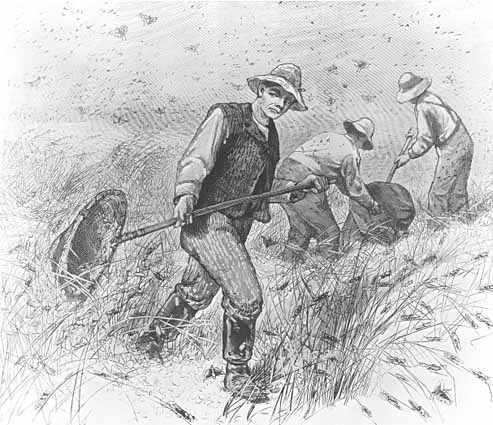Topics
Category
Era
Grasshopper Plagues, 1873–1877
On June 12, 1873, farmers in southwestern Minnesota saw what looked like a snowstorm coming towards their fields from the west. Then they heard a roar of beating wings and saw that what seemed to be snowflakes were in fact grasshoppers. In a matter of hours, knee-high fields of grass and wheat were eaten to the ground by hungry hoppers.
The grasshoppers' dramatic descent was just the beginning. For five years, from 1873 to 1877, grasshoppers destroyed wheat, oat, corn, and barley fields in Minnesota and surrounding states. In 1876 alone, grasshoppers visited forty Minnesota counties and destroyed 500,000 acres of crops.
Grasshoppers, or what scientists call Rocky Mountain locusts, were not new to Minnesota, but in the past, they had stayed for only a year or two. In 1873, they moved into Minnesota from Dakota and Iowa, and they laid their eggs deep in the soil. Minnesota farmers did their best to destroy the grasshopper eggs, so there would be fewer grasshoppers to feast on their crops the next year. But 1874 was worse than 1873. The grasshopper eggs hatched, and more grasshoppers flew in from the west. Each year until 1877, the grasshoppers spread further into Minnesota. Since they moved in separate units, they destroyed large sections of crops in some areas and left other areas untouched.
Minnesota farmers tried many things to get rid of the grasshoppers. They beat the grasshoppers with flails. They dragged heavy ropes through their fields, and plowed and burned their fields. They raised birds and chickens to eat the grasshoppers. They dug ditches that they hoped the grasshoppers would be unable to jump over. They filled these ditches with coal tar and set them on fire, thinking that the smoke might drive away the hoppers if the ditches did not. In later years, farmers made "hopper dozers," which consisted of sheet metal covered in coal tar or molasses. They dragged the hopper dozers through their fields, catching grasshoppers in pans and then emptying the pans into fires. None of these efforts were successful.
County governments instituted efforts to rid the state of grasshoppers and to help destitute farmers, but counties provided much less help than farmers needed. Rural counties were less prepared to provide help to the poor than cities were. Rural areas also lacked the private charitable organizations that assisted the urban poor. In addition, despite extensive damage to crops, some questioned whether farmers' crops had really been devastated and whether farmers were really in need.
The state, governed by three different men during the grasshopper plague years, also failed to provide adequate relief to affected farmers. Under governors Horace Austin and Cushman K. Davis, the state provided small sums of direct, state-funded relief, but the governors focused their efforts on encouraging charitable giving to the cause. Unlike his predecessors, Governor John S. Pillsbury did not call for any direct, state-funded relief for farmers. Elected in 1876, Pillsbury believed that poverty was a fact of life on the frontier and that providing relief would make farmers dependent on the state. Instead, Pillsbury focused on efforts to eradicate the grasshoppers. This included a controversial bounty measure that required every able-bodied man in affected counties to destroy grasshopper eggs for one day a week, for five straight weeks.
In the summer of 1877, the grasshoppers left just as quickly as they had arrived. An April snowstorm damaged many of their eggs, which encouraged farmers to redouble their efforts to destroy the grasshoppers. The surviving grasshopper eggs hatched, but by August, the grasshoppers had flown away. Many attributed the end of the grasshopper plague to divine intervention, since Governor Pillsbury had proclaimed April 26 a day of prayer, after receiving many requests to do so.
It was another decade before swarms of grasshoppers returned to Minnesota, and it was not until the 1930s that the state experienced another plague like that of the 1870s. But the grasshopper plagues of the 1870s left a mark on Minnesota culture, inspiring fiction like Laura Ingalls Wilder's On the Banks of Plum Creek (1937) and Ole Edvart Rølvaag's Giants in the Earth (originally published in Norwegian in 1927 as Verdens Grøde).
Bibliography
Atkins, Annette. Harvest of Grief: Grasshopper Plagues and Public Assistance in Minnesota, 1873–89. St. Paul: Minnesota Historical Society Press, 1984.
Folwell, William Watts. A History of Minnesota. Vol. 3. St. Paul: Minnesota Historical Society, 1969. First published in 1926.
P939
Barnum, George Granville, Reminiscences and Memoranda, 1935
Manuscript Collection, Minnesota Historical Society, St. Paul
Description: Five typed manuscripts, including one called "Locusts" that describes the grasshopper infestation.
Related Resources
Primary
Fite, Gilbert C., ed. "Some Farmers' Accounts of Hardship on the Frontier." Minnesota History 37, no. 5: 204–211.
http://collections.mnhs.org/MNHistoryMagazine/articles/37/v37i05p204-211.pdf
Wise, John C. The Grasshopper, or Rocky Mountain Locust, and its Ravages in Minnesota: A Special Report to the Hon. C. K. Davis, Governor of Minnesota. St. Paul: Pioneer Press Company, 1876.
P939
White, Emma C.
Memoirs of a grandmother eighty-three years old, 1930
Manuscript Collection, Minnesota Historical Society, St. Paul
Description: Typewritten account of White's recollections, including comments on the 1875 grasshopper infestation.
P1893
A.K. Rollag and Mrs. Ole Rollag Reminiscences, 1929, 1938
Manuscript Collection, Minnesota Historical Society, St. Paul
Description: Typewritten reminiscences of rural life in southwestern Minnesota (1873–1890) by two Norwegian immigrants, translated from Norwegian by Brynhild Rowberg. Mrs. Rollag's account recalls the grasshopper infestation.
P2081
The Farmer Collection of Reminiscences, 1949, 1958
Manuscript Collection, Minnesota Historical Society, St. Paul
Description: Reminiscent letters written by farmers from Minnesota, Wisconsin, North Dakota, and South Dakota for the Minnesota Territorial Centennial and Statehood Centennial editions of The Farmer, a magazine published at St. Paul, Minnesota. Some of the letters pertain to the grasshopper invasions.
Gubernatorial Records of Governor Cushman K. Davis, 1874–1882
State Archives Collection, Minnesota Historical Society, St. Paul
http://www2.mnhs.org/library/findaids/gov021.xml
Description: Assorted files on public policy matters, including materials relating to "frontier relief" and grasshopper relief.
Gubernatorial Records of Governor John S. Pillsbury, 1876–1882
State Archives Collection, Minnesota Historical Society, St. Paul
http://www2.mnhs.org/library/findaids/gr00626.xml
Description: Assorted files on public policy matters, including materials relating to public lands, railroads, grasshopper relief, seed grain, pardons, and applications for and appointments to office.
Secondary
Case, C. F. History and Description of Lyon County, Minnesota. Marshall, MN: Messenger Printing House, 1884.
Hughes, Thomas. History of Blue Earth County. Chicago: Middle West Publishing Company, 1909.
Trenerry, Walter N. "The Minnesota Legislator and the Grasshopper, 1873–77." Minnesota History 36, no. 3 (June 1958): 54–61.
http://collections.mnhs.org/mnhistorymagazine/articles/36/v36i02p054-061.pdf
Ubl, Elroy E. "Two Other Early Disasters: Grasshoppers and Tornados," in The Matter Lies Deeper. New Ulm, MN: E. E. Ubl, 2004.
Webb, Wayne E., and Swedberg, J.T. Redwood, the Story of a County. Minnesota: Redwood County Board of Commissioners, 1964.
Related Audio
MN90: A 19th Century Grasshopper Disaster
All rights reserved
Holding Location
More Information
Articles
Related Images

Minnesota locusts of the 1870s
Public domain
Holding Location
Articles

Locust Egg Map of Minnesota, 1877
Public domain
Holding Location
Articles

Grangers versus Grasshoppers
Public domain
Holding Location
Articles

Grasshopper plague in Minnesota
Public domain
Holding Location
Related Articles
Turning Point
The grasshoppers fly away in August of 1877, already weakened by an April snowstorm and renewed farmer efforts to destroy them.
Chronology
1873
1874
1876
1877
Bibliography
Atkins, Annette. Harvest of Grief: Grasshopper Plagues and Public Assistance in Minnesota, 1873–89. St. Paul: Minnesota Historical Society Press, 1984.
Folwell, William Watts. A History of Minnesota. Vol. 3. St. Paul: Minnesota Historical Society, 1969. First published in 1926.
P939
Barnum, George Granville, Reminiscences and Memoranda, 1935
Manuscript Collection, Minnesota Historical Society, St. Paul
Description: Five typed manuscripts, including one called "Locusts" that describes the grasshopper infestation.
Related Resources
Primary
Fite, Gilbert C., ed. "Some Farmers' Accounts of Hardship on the Frontier." Minnesota History 37, no. 5: 204–211.
http://collections.mnhs.org/MNHistoryMagazine/articles/37/v37i05p204-211.pdf
Wise, John C. The Grasshopper, or Rocky Mountain Locust, and its Ravages in Minnesota: A Special Report to the Hon. C. K. Davis, Governor of Minnesota. St. Paul: Pioneer Press Company, 1876.
P939
White, Emma C.
Memoirs of a grandmother eighty-three years old, 1930
Manuscript Collection, Minnesota Historical Society, St. Paul
Description: Typewritten account of White's recollections, including comments on the 1875 grasshopper infestation.
P1893
A.K. Rollag and Mrs. Ole Rollag Reminiscences, 1929, 1938
Manuscript Collection, Minnesota Historical Society, St. Paul
Description: Typewritten reminiscences of rural life in southwestern Minnesota (1873–1890) by two Norwegian immigrants, translated from Norwegian by Brynhild Rowberg. Mrs. Rollag's account recalls the grasshopper infestation.
P2081
The Farmer Collection of Reminiscences, 1949, 1958
Manuscript Collection, Minnesota Historical Society, St. Paul
Description: Reminiscent letters written by farmers from Minnesota, Wisconsin, North Dakota, and South Dakota for the Minnesota Territorial Centennial and Statehood Centennial editions of The Farmer, a magazine published at St. Paul, Minnesota. Some of the letters pertain to the grasshopper invasions.
Gubernatorial Records of Governor Cushman K. Davis, 1874–1882
State Archives Collection, Minnesota Historical Society, St. Paul
http://www2.mnhs.org/library/findaids/gov021.xml
Description: Assorted files on public policy matters, including materials relating to "frontier relief" and grasshopper relief.
Gubernatorial Records of Governor John S. Pillsbury, 1876–1882
State Archives Collection, Minnesota Historical Society, St. Paul
http://www2.mnhs.org/library/findaids/gr00626.xml
Description: Assorted files on public policy matters, including materials relating to public lands, railroads, grasshopper relief, seed grain, pardons, and applications for and appointments to office.
Secondary
Case, C. F. History and Description of Lyon County, Minnesota. Marshall, MN: Messenger Printing House, 1884.
Hughes, Thomas. History of Blue Earth County. Chicago: Middle West Publishing Company, 1909.
Trenerry, Walter N. "The Minnesota Legislator and the Grasshopper, 1873–77." Minnesota History 36, no. 3 (June 1958): 54–61.
http://collections.mnhs.org/mnhistorymagazine/articles/36/v36i02p054-061.pdf
Ubl, Elroy E. "Two Other Early Disasters: Grasshoppers and Tornados," in The Matter Lies Deeper. New Ulm, MN: E. E. Ubl, 2004.
Webb, Wayne E., and Swedberg, J.T. Redwood, the Story of a County. Minnesota: Redwood County Board of Commissioners, 1964.





